
Illustrative Math Alignment: Grade 7 Unit 7
Expressions, Equations, and Inequalities
Lesson 23: Applications of Expressions
Use the following Media4Math resources with this Illustrative Math lesson.
| Thumbnail Image | Title | Body | Curriculum Topic |
|---|---|---|---|
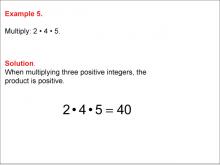
|
Math Example--Numerical Expressions--Multiplying Integers: Example 5 | Math Example--Numerical Expressions--Multiplying Integers: Example 5TopicNumerical Expressions DescriptionExample 5 illustrates the multiplication of three positive integers: 2 × 4 × 5. The solution demonstrates that when multiplying multiple positive numbers, the result remains positive. In this case, 2 × 4 × 5 = 40. This collection of examples explores various scenarios of integer multiplication, helping students understand the rules governing the multiplication of positive and negative numbers. By presenting different combinations, including multiple factors, students can recognize patterns and develop a solid foundation for more complex mathematical operations. |
Numerical Expressions |
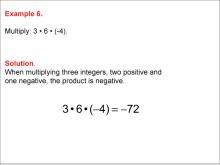
|
Math Example--Numerical Expressions--Multiplying Integers: Example 6 | Math Example--Numerical Expressions--Multiplying Integers: Example 6TopicNumerical Expressions DescriptionExample 6 demonstrates the multiplication of three integers, including a negative number: 3 × 6 × (-4). The solution shows that when multiplying multiple numbers with one negative factor, the result is negative. In this case, 3 × 6 × (-4) = -72. |
Numerical Expressions |

|
Math Example--Numerical Expressions--Multiplying Integers: Example 7 | Math Example--Numerical Expressions--Multiplying Integers: Example 7TopicNumerical Expressions DescriptionExample 7 presents the multiplication of three integers with a negative number in the middle: 2 × (-5) × 6. The solution demonstrates that the position of the negative number doesn't affect the result, which is negative when there's an odd number of negative factors. In this case, 2 × (-5) × 6 = -60. |
Numerical Expressions |
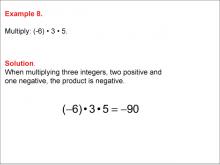
|
Math Example--Numerical Expressions--Multiplying Integers: Example 8 | Math Example--Numerical Expressions--Multiplying Integers: Example 8TopicNumerical Expressions DescriptionExample 8 depicts the multiplication of three integers with a negative number at the beginning: (-6) × 3 × 5. The solution shows that the position of the negative number doesn't affect the result, which is negative when there's an odd number of negative factors. In this case, (-6) × 3 × 5 = -90. |
Numerical Expressions |
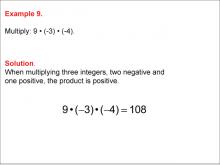
|
Math Example--Numerical Expressions--Multiplying Integers: Example 9 | Math Example--Numerical Expressions--Multiplying Integers: Example 9TopicNumerical Expressions DescriptionExample 9 demonstrates the multiplication of three integers: 9, -3, and -4. The solution shows that when multiplying three integers with two negative numbers and one positive number, the result is positive. In this case, 9 × (-3) × (-4) = 108. |
Numerical Expressions |
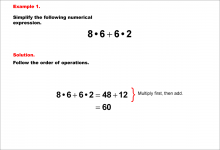
|
Math Example--Numerical Expressions--Order of Operations--Example 01 | Math Example--Numerical Expressions--Order of Operations--Example 01
Watch the following video on Order of Operations. (The transcript is included.) Video Transcript
A numerical expression includes numbers and operation symbols, addition, subtraction, multiplication, and division. Because addition is commutative, adding from left to right, or right to left, gives you the same result. The expressions 2 + 3 and 3 + 2 give the same result. But this isn't the case with all operations. |
Numerical Expressions |
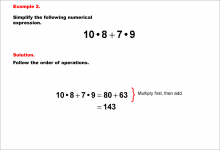
|
Math Example--Numerical Expressions--Order of Operations--Example 02 | Math Example--Numerical Expressions--Order of Operations--Example 02
Watch the following video on Order of Operations. (The transcript is included.)
Video Transcript A numerical expression includes numbers and operation symbols, addition, subtraction, multiplication, and division. Because addition is commutative, adding from left to right, or right to left, gives you the same result. The expressions 2 + 3 and 3 + 2 give the same result. But this isn't the case with all operations. Subtraction isn't commutative. |
Numerical Expressions |
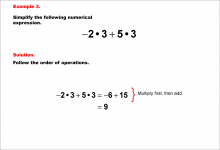
|
Math Example--Numerical Expressions--Order of Operations--Example 03 | Math Example--Numerical Expressions--Order of Operations--Example 03
Watch the following video on Order of Operations. (The transcript is included.)
Video Transcript A numerical expression includes numbers and operation symbols, addition, subtraction, multiplication, and division. Because addition is commutative, adding from left to right, or right to left, gives you the same result. The expressions 2 + 3 and 3 + 2 give the same result. But this isn't the case with all operations. Subtraction isn't commutative. |
Numerical Expressions |
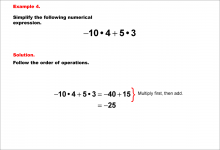
|
Math Example--Numerical Expressions--Order of Operations--Example 04 | Math Example--Numerical Expressions--Order of Operations--Example 04
Watch the following video on Order of Operations. (The transcript is included.) Video Transcript
A numerical expression includes numbers and operation symbols, addition, subtraction, multiplication, and division. Because addition is commutative, adding from left to right, or right to left, gives you the same result. The expressions 2 + 3 and 3 + 2 give the same result. But this isn't the case with all operations. |
Numerical Expressions |

|
Math Example--Numerical Expressions--Order of Operations--Example 05 | Math Example--Numerical Expressions--Order of Operations--Example 05
Watch the following video on Order of Operations. (The transcript is included.) Video Transcript
A numerical expression includes numbers and operation symbols, addition, subtraction, multiplication, and division. Because addition is commutative, adding from left to right, or right to left, gives you the same result. The expressions 2 + 3 and 3 + 2 give the same result. But this isn't the case with all operations. |
Numerical Expressions |
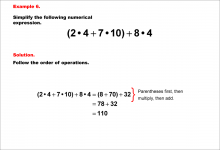
|
Math Example--Numerical Expressions--Order of Operations--Example 06 | Math Example--Numerical Expressions--Order of Operations--Example 06
Watch the following video on Order of Operations. (The transcript is included.) Video Transcript
A numerical expression includes numbers and operation symbols, addition, subtraction, multiplication, and division. Because addition is commutative, adding from left to right, or right to left, gives you the same result. The expressions 2 + 3 and 3 + 2 give the same result. But this isn't the case with all operations. |
Numerical Expressions |
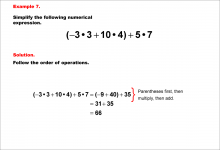
|
Math Example--Numerical Expressions--Order of Operations--Example 07 | Math Example--Numerical Expressions--Order of Operations--Example 07
Watch the following video on Order of Operations. (The transcript is included.) Video Transcript
A numerical expression includes numbers and operation symbols, addition, subtraction, multiplication, and division. Because addition is commutative, adding from left to right, or right to left, gives you the same result. The expressions 2 + 3 and 3 + 2 give the same result. But this isn't the case with all operations. |
Numerical Expressions |
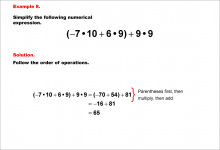
|
Math Example--Numerical Expressions--Order of Operations--Example 08 | Math Example--Numerical Expressions--Order of Operations--Example 08
Watch the following video on Order of Operations. (The transcript is included.) Video Transcript
A numerical expression includes numbers and operation symbols, addition, subtraction, multiplication, and division. Because addition is commutative, adding from left to right, or right to left, gives you the same result. The expressions 2 + 3 and 3 + 2 give the same result. But this isn't the case with all operations. |
Numerical Expressions |
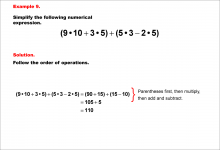
|
Math Example--Numerical Expressions--Order of Operations--Example 09 | Math Example--Numerical Expressions--Order of Operations--Example 09
Watch the following video on Order of Operations. (The transcript is included.) Video Transcript
A numerical expression includes numbers and operation symbols, addition, subtraction, multiplication, and division. Because addition is commutative, adding from left to right, or right to left, gives you the same result. The expressions 2 + 3 and 3 + 2 give the same result. But this isn't the case with all operations. |
Numerical Expressions |
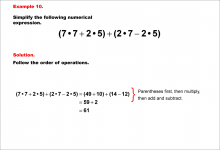
|
Math Example--Numerical Expressions--Order of Operations--Example 10 | Math Example--Numerical Expressions--Order of Operations--Example 10
Watch the following video on Order of Operations. (The transcript is included.) Video Transcript
A numerical expression includes numbers and operation symbols, addition, subtraction, multiplication, and division. Because addition is commutative, adding from left to right, or right to left, gives you the same result. The expressions 2 + 3 and 3 + 2 give the same result. But this isn't the case with all operations. |
Numerical Expressions |
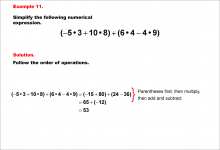
|
Math Example--Numerical Expressions--Order of Operations--Example 11 | Math Example--Numerical Expressions--Order of Operations--Example 11
Watch the following video on Order of Operations. (The transcript is included.) Video Transcript
A numerical expression includes numbers and operation symbols, addition, subtraction, multiplication, and division. Because addition is commutative, adding from left to right, or right to left, gives you the same result. The expressions 2 + 3 and 3 + 2 give the same result. But this isn't the case with all operations. |
Numerical Expressions |
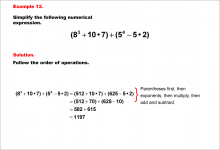
|
Math Example--Numerical Expressions--Order of Operations--Example 12 | Math Example--Numerical Expressions--Order of Operations--Example 12
Watch the following video on Order of Operations. (The transcript is included.) Video Transcript
A numerical expression includes numbers and operation symbols, addition, subtraction, multiplication, and division. Because addition is commutative, adding from left to right, or right to left, gives you the same result. The expressions 2 + 3 and 3 + 2 give the same result. But this isn't the case with all operations. |
Numerical Expressions |
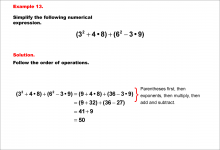
|
Math Example--Numerical Expressions--Order of Operations--Example 13 | Math Example--Numerical Expressions--Order of Operations--Example 13
Watch the following video on Order of Operations. (The transcript is included.) Video Transcript
A numerical expression includes numbers and operation symbols, addition, subtraction, multiplication, and division. Because addition is commutative, adding from left to right, or right to left, gives you the same result. The expressions 2 + 3 and 3 + 2 give the same result. But this isn't the case with all operations. |
Numerical Expressions |
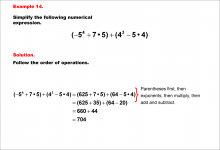
|
Math Example--Numerical Expressions--Order of Operations--Example 14 | Math Example--Numerical Expressions--Order of Operations--Example 14
Watch the following video on Order of Operations. (The transcript is included.) Video Transcript
A numerical expression includes numbers and operation symbols, addition, subtraction, multiplication, and division. Because addition is commutative, adding from left to right, or right to left, gives you the same result. The expressions 2 + 3 and 3 + 2 give the same result. But this isn't the case with all operations. |
Numerical Expressions |
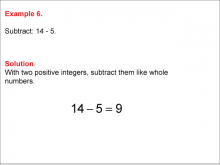
|
Math Example--Numerical Expressions--Subtracting Two Integers: Example 06 | Math Example--Numerical Expressions--Subtracting Two Integers: Example 06TopicIntegers DescriptionThis example demonstrates the operation: Subtract: 14 - 5. The solution states to subtract them like whole numbers. 14 - 5 = 9. Integer operations are fundamental in mathematics as they provide essential skills for tackling more advanced topics. This collection explores various examples of integer subtraction, showcasing how the rules apply across diverse scenarios. Such a variety helps learners grasp the concepts effectively. |
Numerical Expressions |
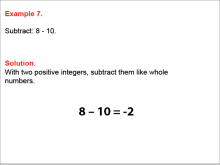
|
Math Example--Numerical Expressions--Subtracting Two Integers: Example 07 | Math Example--Numerical Expressions--Subtracting Two Integers: Example 07TopicIntegers DescriptionThis example demonstrates the operation: Subtract: 8 - 10. The solution 8 = 10 = -2. Integer operations are fundamental in mathematics as they provide essential skills for tackling more advanced topics. This collection explores various examples of integer subtraction, showcasing how the rules apply across diverse scenarios. Such a variety helps learners grasp the concepts effectively. |
Numerical Expressions |
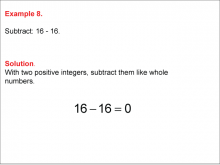
|
Math Example--Numerical Expressions--Subtracting Two Integers: Example 08 | Math Example--Numerical Expressions--Subtracting Two Integers: Example 08TopicIntegers DescriptionThis example demonstrates the operation: Subtract: 16 - 16. The solution shows that 16 - 16 = 0. Integer operations are fundamental in mathematics as they provide essential skills for tackling more advanced topics. This collection explores various examples of integer subtraction, showcasing how the rules apply across diverse scenarios. Such a variety helps learners grasp the concepts effectively. |
Numerical Expressions |
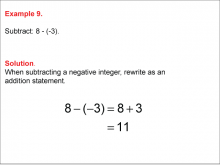
|
Math Example--Numerical Expressions--Subtracting Two Integers: Example 09 | Math Example--Numerical Expressions--Subtracting Two Integers: Example 09TopicIntegers DescriptionThis example demonstrates the operation: Subtract: 8 - (-3). The solution shows that it is rewritten as addition: 8 + 3 = 11. Integer operations are fundamental in mathematics as they provide essential skills for tackling more advanced topics. This collection explores various examples of integer subtraction, showcasing how the rules apply across diverse scenarios. Such a variety helps learners grasp the concepts effectively. |
Numerical Expressions |
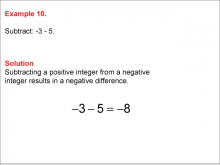
|
Math Example--Numerical Expressions--Subtracting Two Integers: Example 10 | Math Example--Numerical Expressions--Subtracting Two Integers: Example 10TopicIntegers DescriptionThis example demonstrates the operation: Subtract: -3 - 5. Solution: Subtracting a positive integer from a negative integer results in a negative difference. -3 - 5 = -8. Integer operations are fundamental in mathematics as they provide essential skills for tackling more advanced topics. This collection explores various examples of integer subtraction, showcasing how the rules apply across diverse scenarios. Such a variety helps learners grasp the concepts effectively. |
Numerical Expressions |
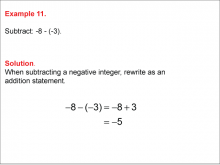
|
Math Example--Numerical Expressions--Subtracting Two Integers: Example 11 | Math Example--Numerical Expressions--Subtracting Two Integers: Example 11TopicIntegers DescriptionThis example demonstrates the operation: Subtract: -8 - (-3). Solution involves rewriting the subtraction as an addition statement. -8 + 3 = -5. Integer operations are fundamental in mathematics as they provide essential skills for tackling more advanced topics. This collection explores various examples of integer subtraction, showcasing how the rules apply across diverse scenarios. Such a variety helps learners grasp the concepts effectively. |
Numerical Expressions |
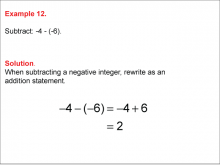
|
Math Example--Numerical Expressions--Subtracting Two Integers: Example 12 | Two Integers: Example 12 TopicIntegers DescriptionThis example demonstrates the operation of subtracting two negative integers: -4 - (-6). The solution shows that when subtracting a negative integer, it can be rewritten as an addition statement: -4 + 6 = 2. Integer operations are crucial in mathematics as they provide foundational skills for more advanced topics. This collection explores various examples of integer subtraction, highlighting how rules apply across different scenarios. Such variety helps learners grasp concepts effectively. |
Numerical Expressions |

|
Math Example--Numerical Expressions--Subtracting Two Integers: Example 13 | Math Example--Numerical Expressions--Subtracting Two Integers: Example 13TopicIntegers DescriptionThis example demonstrates subtracting a negative integer from another negative integer: -7 - (-7). The solution involves rewriting the subtraction as an addition statement, resulting in -7 + 7 = 0. Integer operations are fundamental in mathematics, providing essential skills for tackling more advanced topics. This collection explores various examples of integer subtraction, showcasing how the rules apply across diverse scenarios. Such variety helps learners grasp concepts effectively. |
Numerical Expressions |

|
Math Example--Rational Concepts--Rational Expressions: Example 1 | Math Example--Rational Concepts--Rational Expressions: Example 1TopicRational Expressions DescriptionThis example demonstrates how to combine the rational expressions 1/2 + 1/3. The solution involves finding a common denominator, which is 6, and then adding the fractions to get 5/6. To solve this, we multiply each fraction by the appropriate factor to create equivalent fractions with the common denominator: (1 * 3/3) + (1 * 2/2) = 3/6 + 2/6. Then, we add the numerators while keeping the common denominator: (3 + 2)/6 = 5/6. |
Rational Expressions |
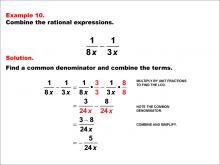
|
Math Example--Rational Concepts--Rational Expressions: Example 10 | Math Example--Rational Concepts--Rational Expressions: Example 10TopicRational Expressions DescriptionThis example demonstrates how to combine the rational expressions 1/(8x) - 1/(3x). The solution involves finding a common denominator, which is 24x, and then subtracting the fractions to get -5/(24x). We multiply each fraction by the appropriate unit fraction to create equivalent fractions with the common denominator: (1 * 3)/(8x * 3) - (1 * 8)/(3x * 8) = 3/(24x) - 8/(24x). Then, we subtract the numerators while keeping the common denominator: (3 - 8)/(24x) = -5/(24x). |
Rational Expressions |

|
Math Example--Rational Concepts--Rational Expressions: Example 11 | Math Example--Rational Concepts--Rational Expressions: Example 11TopicRational Expressions DescriptionThis example illustrates how to combine the rational expressions 2/(3x) + 4/(5x). The solution involves finding a common denominator, which is 15x, and then adding the fractions to get 22/(15x). We multiply each fraction by the appropriate unit fraction to create equivalent fractions with the common denominator: (2 * 5)/(3x * 5) + (4 * 3)/(5x * 3) = 10/(15x) + 12/(15x). Then, we add the numerators while keeping the common denominator: (10 + 12)/(15x) = 22/(15x). |
Rational Expressions |
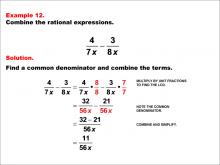
|
Math Example--Rational Concepts--Rational Expressions: Example 12 | Math Example--Rational Concepts--Rational Expressions: Example 12TopicRational Expressions DescriptionThis example demonstrates how to combine the rational expressions 4/(7x) - 3/(8x). The solution involves finding a common denominator, which is 56x, and then subtracting the fractions to get 11/(56x). We multiply each fraction by the appropriate unit fraction to create equivalent fractions with the common denominator: (4 * 8)/(7x * 8) - (3 * 7)/(8x * 7) = 32/(56x) - 21/(56x). Then, we subtract the numerators while keeping the common denominator: (32 - 21)/(56x) = 11/(56x). |
Rational Expressions |
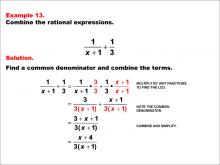
|
Math Example--Rational Concepts--Rational Expressions: Example 13 | Math Example--Rational Concepts--Rational Expressions: Example 13TopicRational Expressions DescriptionThis example illustrates how to combine the rational expressions 1/(x + 1) + 1/3. The solution involves finding a common denominator, which is 3(x + 1), and then adding the fractions to get (x + 4)/(3(x + 1)). We multiply each fraction by the appropriate factor to create equivalent fractions with the common denominator: (1 * 3)/(x + 1) * 3 + (1 * (x + 1))/(3 * (x + 1)) = 3/(3(x + 1)) + (x + 1)/(3(x + 1)). Then, we add the numerators while keeping the common denominator: (3 + x + 1)/(3(x + 1)) = (x + 4)/(3(x + 1)). |
Rational Expressions |
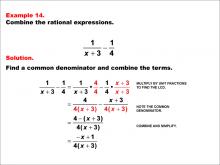
|
Math Example--Rational Concepts--Rational Expressions: Example 14 | Math Example--Rational Concepts--Rational Expressions: Example 14TopicRational Expressions DescriptionThis example demonstrates how to combine the rational expressions 1/(x + 3) - 1/4. The solution involves finding a common denominator, which is 4(x + 3), and then subtracting the fractions to get (-x + 1)/(4(x + 3)). We multiply each fraction by the appropriate factor to create equivalent fractions with the common denominator: (1 * 4)/(x + 3) * 4 - (1 * (x + 3))/(4 * (x + 3)) = 4/(4(x + 3)) - (x + 3)/(4(x + 3)). Then, we subtract the numerators while keeping the common denominator: (4 - (x + 3))/(4(x + 3)) = (-x + 1)/(4(x + 3)). |
Rational Expressions |
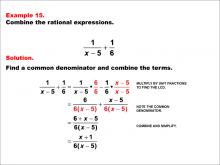
|
Math Example--Rational Concepts--Rational Expressions: Example 15 | Math Example--Rational Concepts--Rational Expressions: Example 15TopicRational Expressions DescriptionThis example demonstrates how to combine the rational expressions 1 / (x - 5) + 1 / 6. The solution involves finding a common denominator, which is 6(x - 5), and then adding the fractions to get (x + 1) / (6(x - 5)). We multiply each fraction by the appropriate factor to create equivalent fractions with the common denominator: (1 * 6) / ((x - 5) * 6) + (1 * (x - 5)) / (6 * (x - 5)) = 6 / (6(x - 5)) + (x - 5) / (6(x - 5)). Then, we add the numerators while keeping the common denominator: (6 + x - 5) / (6(x - 5)) = (x + 1) / (6(x - 5)). |
Rational Expressions |

|
Math Example--Rational Concepts--Rational Expressions: Example 16 | Math Example--Rational Concepts--Rational Expressions: Example 16TopicRational Expressions DescriptionThis example illustrates how to combine the rational expressions 1 / (x - 7) + 1 / 8. The solution involves finding a common denominator, which is 8(x - 7), and then adding the fractions to get (x + 1) / (8(x - 7)). We multiply each fraction by the appropriate factor to create equivalent fractions with the common denominator: (1 * 8) / ((x - 7) * 8) + (1 * (x - 7)) / (8 * (x - 7)) = 8 / (8(x - 7)) + (x - 7) / (8(x - 7)). Then, we add the numerators while keeping the common denominator: (8 + x - 7) / (8(x - 7)) = (x + 1) / (8(x - 7)). |
Rational Expressions |
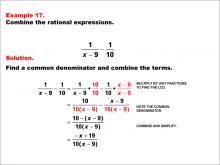
|
Math Example--Rational Concepts--Rational Expressions: Example 17 | Math Example--Rational Concepts--Rational Expressions: Example 17TopicRational Expressions DescriptionThis example demonstrates how to combine the rational expressions 1 / (x - 9) - 1 / 10. The solution involves finding a common denominator, which is 10(x - 9), and then subtracting the fractions to get (-x + 19) / (10(x - 9)). We multiply each fraction by the appropriate factor to create equivalent fractions with the common denominator: (1 * 10) / ((x - 9) * 10) - (1 * (x - 9)) / (10 * (x - 9)) = 10 / (10(x - 9)) - (x - 9) / (10(x - 9)). Then, we subtract the numerators while keeping the common denominator: (10 - (x - 9)) / (10(x - 9)) = (19 - x) / (10(x - 9)) = (-x + 19) / (10(x - 9)). |
Rational Expressions |
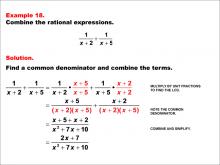
|
Math Example--Rational Concepts--Rational Expressions: Example 18 | Math Example--Rational Concepts--Rational Expressions: Example 18TopicRational Expressions |
Rational Expressions |
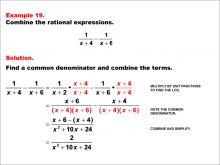
|
Math Example--Rational Concepts--Rational Expressions: Example 19 | Math Example--Rational Concepts--Rational Expressions: Example 19TopicRational Expressions |
Rational Expressions |
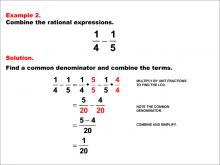
|
Math Example--Rational Concepts--Rational Expressions: Example 2 | Math Example--Rational Concepts--Rational Expressions: Example 2TopicRational Expressions DescriptionThis example illustrates how to combine the rational expressions 1/4 - 1/5. The solution involves finding a common denominator, which is 20, and then subtracting the fractions to get 1/20. We multiply each fraction by the appropriate factor to create equivalent fractions with the common denominator: (1 * 5/5) - (1 * 4/4) = 5/20 - 4/20. Then, we subtract the numerators while keeping the common denominator: (5 - 4)/20 = 1/20. |
Rational Expressions |
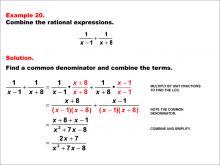
|
Math Example--Rational Concepts--Rational Expressions: Example 20 | Math Example--Rational Concepts--Rational Expressions: Example 20TopicRational Expressions |
Rational Expressions |

|
Math Example--Rational Concepts--Rational Expressions: Example 21 | Math Example--Rational Concepts--Rational Expressions: Example 21TopicRational Expressions |
Rational Expressions |
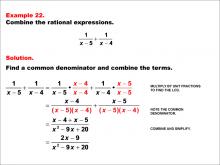
|
Math Example--Rational Concepts--Rational Expressions: Example 22 | Math Example--Rational Concepts--Rational Expressions: Example 22TopicRational Expressions |
Rational Expressions |
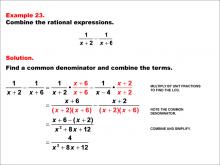
|
Math Example--Rational Concepts--Rational Expressions: Example 23 | Math Example--Rational Concepts--Rational Expressions: Example 23TopicRational Expressions |
Rational Expressions |
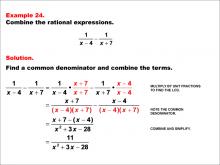
|
Math Example--Rational Concepts--Rational Expressions: Example 24 | Math Example--Rational Concepts--Rational Expressions: Example 24TopicRational Expressions |
Rational Expressions |
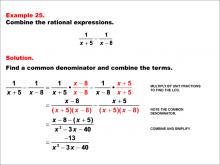
|
Math Example--Rational Concepts--Rational Expressions: Example 25 | Math Example--Rational Concepts--Rational Expressions: Example 25TopicRational Expressions |
Rational Expressions |
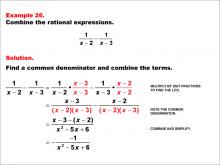
|
Math Example--Rational Concepts--Rational Expressions: Example 26 | Math Example--Rational Concepts--Rational Expressions: Example 26TopicRational Expressions |
Rational Expressions |
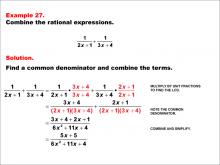
|
Math Example--Rational Concepts--Rational Expressions: Example 27 | Math Example--Rational Concepts--Rational Expressions: Example 27TopicRational Expressions |
Rational Expressions |
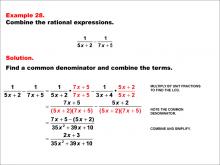
|
Math Example--Rational Concepts--Rational Expressions: Example 28 | Math Example--Rational Concepts--Rational Expressions: Example 28TopicRational Expressions |
Rational Expressions |
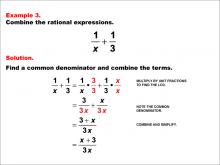
|
Math Example--Rational Concepts--Rational Expressions: Example 3 | Math Example--Rational Concepts--Rational Expressions: Example 3TopicRational Expressions DescriptionThis example demonstrates how to combine the rational expressions 1/x + 1/3. The solution involves finding a common denominator, which is 3x, and then adding the fractions to get (x + 3)/3x. We multiply each fraction by the appropriate factor to create equivalent fractions with the common denominator: (1 * 3/3) + (1 * x/x) = 3/(3x) + x/(3x). Then, we add the numerators while keeping the common denominator: (3 + x)/(3x) = (x + 3)/(3x). |
Rational Expressions |
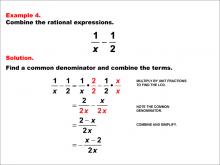
|
Math Example--Rational Concepts--Rational Expressions: Example 4 | Math Example--Rational Concepts--Rational Expressions: Example 4TopicRational Expressions DescriptionThis example illustrates how to combine the rational expressions 1/x - 1/2. The solution involves finding a common denominator, which is 2x, and then subtracting the fractions to get (x - 2)/2x. We multiply each fraction by the appropriate factor to create equivalent fractions with the common denominator: (1 * 2/2) - (1 * x/x) = 2/(2x) - x/(2x). Then, we subtract the numerators while keeping the common denominator: (2 - x)/(2x) = (x - 2)/(2x). |
Rational Expressions |